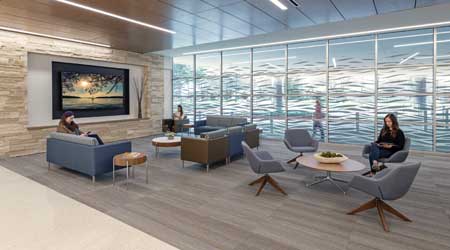How to Help Patients Find Their Way in Healthcare Facilities
Proper wayfinding and good signage is an absolute crucial part of healthcare interiors design. One trend that's helping patients find their way: Smaller, more flexible facilities.
This design discipline has been around for decades, but it has only recently been taken up in a more comprehensive and considered way, to advance their impact on the patient experience and consumer journey. Signage solves a number of functional issues, of course, especially in the design of large, complex institutional or civic projects (anyone who has got lost in an airport will confirm this); but signage can also add two vital elements to any design.
One benefit is place-making. Too often signs are a hasty afterthought or treated as a type of pixie dust that can be sprinkled on to solve a labyrinthine floor plan. This thankfully is changing. Once it solves the functional challenge of getting a patient or visitor from Point A to Point B, well-designed, well-integrated signs contribute to an overall sense of place. They can provide a bit of personality to what can be large, generic spaces — jewelry, if you well, that helps you find your way. Signage can also have an emotional currency that commercial environments, such as hotels and resorts, have understood for decades, but is only recently being tapped by healthcare designers. Considering that many patients or first-time visitors are often overwhelmed and disoriented by a large hospital’s complexity, a well-conceived and clear wayfinding program can make the difference between a positive stay and an emotionally overwrought one.
Another advantage of good signage has to do with human interaction with the building itself. At the heart of this discussion is the way human beings interact with the built environment, and this, obviously, is changing dramatically thanks to wayfinding. At one time, we had to rely on maps — printed, incomprehensibly folded monstrosities — that told us how to navigate the world around us. Maps don’t exist anymore, of course, having been supplanted by the ubiquitous smart phone, which can pinpoint our coordinates and tell us exactly how many steps we need to take to arrive at our destination.
In a case study of Boston Children’s Hospital, the operator implemented a mobile app called MyWay to access hospital maps, serve as a self-locating device and provide step-by-step directions. The Boston Children’s Hospital complex has 12 separate buildings (some interconnected, some detached), constructed over a 150-year span, with six campuses. The MyWay application provides more than locations, also showing photographs of the clinicians and their specialties. The operator reported more than 4,500 downloads in six months and indicated that some 65 percent of users said it improved their experience in the hospital. All good, of course, but then consider the amount of information — the dialogue — that could happen between a building and a visitor, especially one with visual, haptic or auditory challenges.
New ideas on hospital location
For a variety of reasons, the industry is shifting away from acute care hospitals to smaller, more flexible facilities that will present new demands on operations. From a design perspective, these environments will likely feel more like retail stores or day spas and focus overwhelmingly on the patient journey. Issues of efficiency will drive a new way of thinking — how can we bring care closer to the consumer. Or, better, how can we administer care more efficiently and seamlessly, as well as closer to the consumer.
While the $69-billion merger of CVS Health and Aetna isn’t a done deal despite having received the blessing of federal officials and the two companies moving to integrate their businesses, the partnership does suggest changes ahead for the provision of some healthcare services. The merger combines CVS’ pharmacies with Aetna’s insurance business, blurring traditionally distinct lines in hopes of lowering costs. It also puts the potential healthcare outlet on virtually every corner or strip center in the nation. Even if the deal falls through, this does seem to be where the industry is heading — smaller, more consumer-focused, and accessible. And this, of course, represents a sea change in how providers will operate.
The relationship people have with the built environment is changing and becoming more symbiotic. Nowhere is this more evident — and more critical — than in healthcare environments.
Dan Thomas (dan.thomas@crtkl.com), AIA, ACHA, EDAC, is vice president of CallisonRTKL. He has more than 25 years of experience in healthcare design and planning domestically and internationally.
Related Topics:













